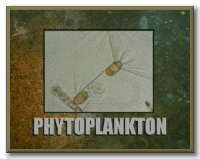Phytoplankton are free-floating and drifting plants, found in the ocean, and comprise the first link in the food chain. Diatoms are an important component of Antarctic marine phytoplankton and number about 100 species; other groups, the "dino-flagellates" with about 70 species, and the silico-flagellates are present also. These phytoplankton, usually single-celled and microscopic, play the key photosynthetic role by converting solar energy into chemical energy. Concentrations of diatoms are seen as a greenish discoloration of surface waters. Phytoplankton-laden waters provide food for krill and countless other tiny floating animals (the zooplankton), which are themselves consumed by carnivores.
Seasonal and geographical variations in the amount of phytoplankton are conspicuous in the Southern Ocean. Large standing "crops" of these miniscule plants are found in the Scotia Sea, west of the Antarctic Peninsula and in the Ross Sea. (Note how marine biologist Robin Ross talks of plankton as the "grasses" of the Antarctic in program 3.) Small standing crops are more typical of the oceanic regions, i.e. away from the coast.
|
|
|
WANT TO LEARN MORE?
|
|
Websites
• Antarctic phytoplankton food of antarctic krill (Euphausia superba) Images and information about phytoplankton in Antarctica including links to articles. • Antarctic Algae Images and background information on algae in Antarctica. • Antarctic Biology and Medicine Information about the biological ecosystems of Antarctica and how the animals adapt to the extreme climate. • Underwater Field Guide to Ross Island & McMurdo Sound, Antarctica Images of the organisms living on Ross Island and McMurdo Sound. • Prehistory More background information on the prehistory of Antarctica. |
![]()
